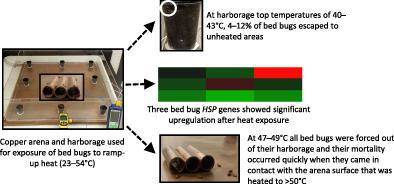当前位置:
X-MOL 学术
›
Pest Manag. Sci.
›
论文详情
Our official English website, www.x-mol.net, welcomes your feedback! (Note: you will need to create a separate account there.)
Characterization of heat exposure-associated escape behaviors and HSP gene expression in bed bugs (Cimex lectularius L.)
Pest Management Science ( IF 4.1 ) Pub Date : 2021-09-01 , DOI: 10.1002/ps.6620 Aaron R Ashbrook 1 , Jeffrey L Feder 2 , Michael E Scharf 1 , Gary W Bennett 1 , Ameya D Gondhalekar 1
Pest Management Science ( IF 4.1 ) Pub Date : 2021-09-01 , DOI: 10.1002/ps.6620 Aaron R Ashbrook 1 , Jeffrey L Feder 2 , Michael E Scharf 1 , Gary W Bennett 1 , Ameya D Gondhalekar 1
Affiliation

|
Heat can be effective for bed bug elimination. However, in some cases bed bugs survive heat treatments. The objectives of this study were to determine the behavioral responses of bed bugs to rising harborage temperatures (23.0–49.0 °C) and identify which heat shock protein (HSP) genes are expressed after heat exposure. First, a custom-made copper arena and harborage were used to determine the escape behaviors of six bed bug populations. Next, HSP gene expression responses of select populations were determined after heat exposure using real time quantitative polymerase chain reaction (RT-qPCR).
中文翻译:

臭虫 (Cimex lectularius L.) 中热暴露相关逃逸行为和 HSP 基因表达的表征
加热可以有效消除臭虫。然而,在某些情况下,臭虫在热处理后仍能存活。本研究的目的是确定臭虫对升高的栖息地温度(23.0-49.0°C)的行为反应,并确定哪些热休克蛋白 ( HSP ) 基因在热暴露后表达。首先,使用定制的铜竞技场和栖息地来确定六个臭虫种群的逃逸行为。接下来,在热暴露后使用实时定量聚合酶链反应 (RT-qPCR) 确定选定人群的HSP基因表达反应。
更新日期:2021-09-01
中文翻译:

臭虫 (Cimex lectularius L.) 中热暴露相关逃逸行为和 HSP 基因表达的表征
加热可以有效消除臭虫。然而,在某些情况下,臭虫在热处理后仍能存活。本研究的目的是确定臭虫对升高的栖息地温度(23.0-49.0°C)的行为反应,并确定哪些热休克蛋白 ( HSP ) 基因在热暴露后表达。首先,使用定制的铜竞技场和栖息地来确定六个臭虫种群的逃逸行为。接下来,在热暴露后使用实时定量聚合酶链反应 (RT-qPCR) 确定选定人群的HSP基因表达反应。



























 京公网安备 11010802027423号
京公网安备 11010802027423号